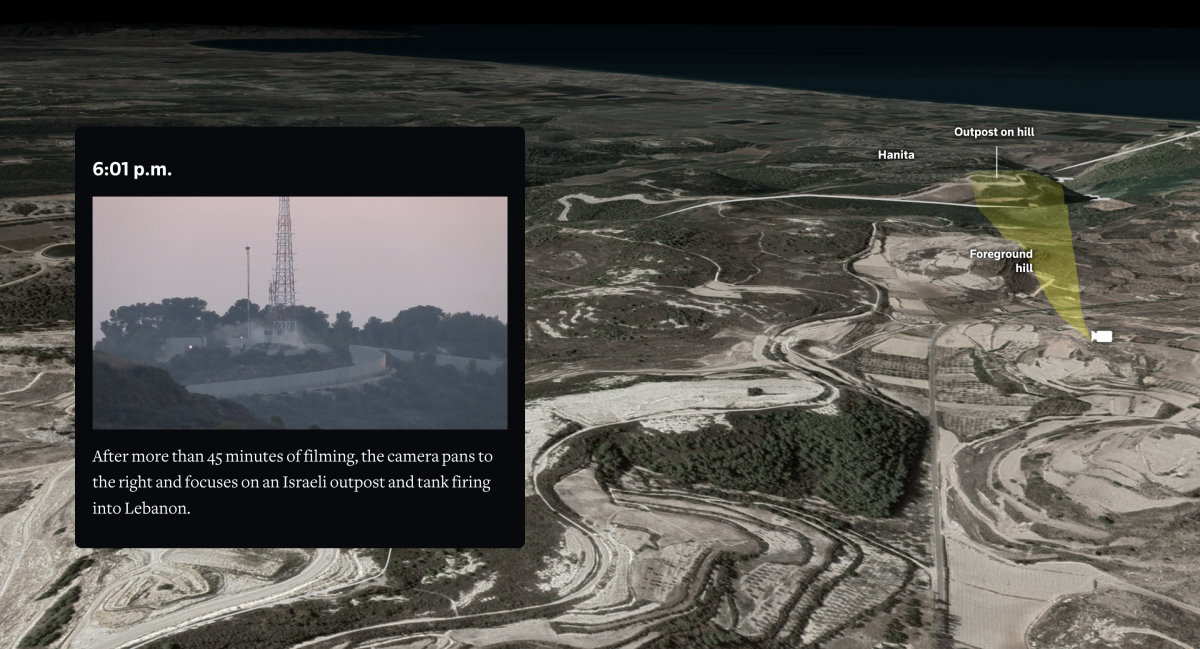Take a look inside Reuters’ investigative report on death of colleague Issam Abdallah during Israel-Hamas war
On Oct. 13, 2023, as the fighting in Gaza spread to other parts of the region, Reuters journalist Issam Abdallah was killed by a shell from an Israeli tank firing into Lebanon. Abdallah, 37, and journalists from multiple news agencies were filming a cross-border firing between Israel and Lebanon in a non-active combat zone when the shelling occurred.
A months-long investigation followed, led by Reuters journalists Maya Gebeily, bureau chief for Lebanon, Syria and Jordan and Anthony Deutsch, Netherlands bureau chief, who has extensive experience covering war crimes.
The result was a one-of-a-kind, detailed multimedia report that draws one definitive conclusion: The Israeli tank crew targeted the press, killing Abdallah.

“This was the most important thing I’ve ever done,” said Gebeily.
Since 2007, Abdallah worked as a visual journalist for Reuters. Gebeily reminisced about how Abdallah was always a bright addition to her day. He was a skilled reporter with a knack for uncovering the essence of every story, as well as a humorous team member and friend.
The report is more than an investigation. It strives to achieve justice, offer a sense of closure to those who grieve and serve as a tribute to Abdallah.
“We wanted it to honor Issam, being a visual journalist,” said Deutsch. “We wanted it to be the best piece of journalism that we could produce, but also to be a visual piece of journalism.”
The report uncovers the incident in tremendous detail, employing photos, videos, maps and graphics to reconstruct the events leading up to the shelling. It presents evidence from the tail fin of the shell that killed Abdallah to the audio analysis of the strikes. The investigation involved “leaving no stone unturned,” according to Gebeily, to produce an ironclad report foreseeing the scrutiny that it would come under.
Key priorities were preserving the integrity of the evidence, from the shrapnel on the ground, to the tripods, cameras and flak jackets, to the digital evidence in the cameras and SIM cards, as well as following the chain of custody. Producing the project was a herculean effort from the Reuters team.
Gebeily and Deutsch said the most challenging part was the physical and mental exhaustion as the team tried to balance their own grieving process along with the investigation.

“It’s probably the most intense bit of journalism I’ve ever done because it involved somebody known and loved within the bureau,” said Deutsch. “I always feel a sense of urgency, especially when reporting about aspects of a war that have a profound impact on people’s lives. In this case, it weighed even more heavily.”
The intended audience for the report was multifaceted. With a complicated project like this, the finer details evolved as the reporting did. The aim was to make it accessible for every reader, be it a war crime investigator or a journalism student, according to Gebeily.
“We wanted to make sure that they knew that we had gone to the furthest lengths to produce something of such high caliber,” said Gebeily, referring to Abdallah’s family and friends. “When somebody who knew him personally is going to read this story, are they going to feel a small sense of relief and some kind of closure?”
The visual representation of the report was paramount from the outset.
“The way the story is laid out on the page is a really powerful example of how text, visuals, graphics and video can work together to present a really powerful story,” said Gebeily.
The scrollytelling, created by the graphics team with the minute-by-minute recreation of the day, involved meticulous analysis of hours of footage — footage that included difficult visuals of the immediate aftermath of the attack.
The decision making became an exercise in selecting appropriate media to convey the message without being sensationalistic, said Deutsch.
Amid ongoing violence in Gaza and the innumerable journalists’ fatalities, the investigation is colossally significant. The report has helped bring important conversations to the forefront, sparking critical discussions and calls for accountability.
“I think we really reinjected a sense of diligence into the journalistic work of this type, especially in a context like Lebanon where accountability has been a very difficult thing to achieve,” said Gebeily.
Gebeily and Deutsch became emotional talking about producing the story and their commitment to doing right by a colleague and friend.
“The important thing is that we have a rock solid piece of journalism that not only honors Issam, but also sets the facts straight,” said Deutsch. “And they’re not going anywhere, those facts.”
Editor’s note: The piece originally stated that the tank was targeting Hezbollah in Lebanon. This is incorrect — the tank was targeting journalists. We regret the error.





